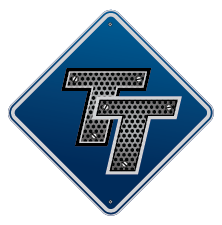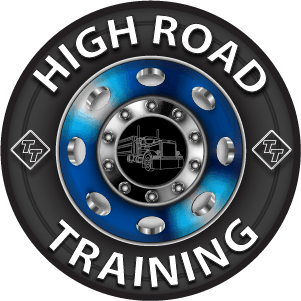CDL Exam Road Trip Advice
Topic 34653 | Page 1
Hi, Fen. I teach CDL and I know the right turn is the "biggie" in passing the road test. It sounds like your "setup" is ok - moving your truck to the left "edge" of the lane before you start the turn.
You must live in (inhabit) the right-side mirror until your tandems begin to move out from the curb. The danger zone is not in the setup but in the last third of the turn. That's when your tandems seem to drift over to that curb.
The simple solution: keep your front end (where you sit and drive the truck) out to the left - the middle of the street kind of thing - until the tandems begin to move away from the curb. Then turn the steering wheel back to the right and getting your truck together in the right-hand lane.
CDL:
Commercial Driver's License (CDL)
A CDL is required to drive any of the following vehicles:
- Any combination of vehicles with a gross combined weight rating (GCWR) of 26,001 or more pounds, providing the gross vehicle weight rating (GVWR) of the vehicle being towed is in excess of 10,000 pounds.
- Any single vehicle with a GVWR of 26,001 or more pounds, or any such vehicle towing another not in excess of 10,000 pounds.
- Any vehicle, regardless of size, designed to transport 16 or more persons, including the driver.
- Any vehicle required by federal regulations to be placarded while transporting hazardous materials.
Tandems:
Tandem Axles
A set of axles spaced close together, legally defined as more than 40 and less than 96 inches apart by the USDOT. Drivers tend to refer to the tandem axles on their trailer as just "tandems". You might hear a driver say, "I'm 400 pounds overweight on my tandems", referring to his trailer tandems, not his tractor tandems. Tractor tandems are generally just referred to as "drives" which is short for "drive axles".
Tandem:
Tandem Axles
A set of axles spaced close together, legally defined as more than 40 and less than 96 inches apart by the USDOT. Drivers tend to refer to the tandem axles on their trailer as just "tandems". You might hear a driver say, "I'm 400 pounds overweight on my tandems", referring to his trailer tandems, not his tractor tandems. Tractor tandems are generally just referred to as "drives" which is short for "drive axles".
Fen without seeing a picture and you stating this is Maverick I’m guessing your pulling a spread axle flatbed. From your description it sounds like your setup is good. Drive as deep into the lane as you can before turning left. That will give more room for the back axle from the curb.

Hi Errol,
Thank you so much for the tips and advice. I will definitely apply this during our drive on Monday.
You absolutely nailed it, it's that last third of the maneuver that's getting me. I just hope I can get the hang of it by Wednesday!
Thanks again for your response!
Fen hopes:
I can get the hang of it by Wednesday
The "hang of it" is simply do not turn your steering wheel to the right - wait for the tandems to get away from the curb!
Tandems:
Tandem Axles
A set of axles spaced close together, legally defined as more than 40 and less than 96 inches apart by the USDOT. Drivers tend to refer to the tandem axles on their trailer as just "tandems". You might hear a driver say, "I'm 400 pounds overweight on my tandems", referring to his trailer tandems, not his tractor tandems. Tractor tandems are generally just referred to as "drives" which is short for "drive axles".
Tandem:
Tandem Axles
A set of axles spaced close together, legally defined as more than 40 and less than 96 inches apart by the USDOT. Drivers tend to refer to the tandem axles on their trailer as just "tandems". You might hear a driver say, "I'm 400 pounds overweight on my tandems", referring to his trailer tandems, not his tractor tandems. Tractor tandems are generally just referred to as "drives" which is short for "drive axles".
If it helps, my instructors had me count while looking at the tandems before turning the wheel. Also, be mindful of not cranking the wheel, slow controlled arc.
Tandems:
Tandem Axles
A set of axles spaced close together, legally defined as more than 40 and less than 96 inches apart by the USDOT. Drivers tend to refer to the tandem axles on their trailer as just "tandems". You might hear a driver say, "I'm 400 pounds overweight on my tandems", referring to his trailer tandems, not his tractor tandems. Tractor tandems are generally just referred to as "drives" which is short for "drive axles".
Tandem:
Tandem Axles
A set of axles spaced close together, legally defined as more than 40 and less than 96 inches apart by the USDOT. Drivers tend to refer to the tandem axles on their trailer as just "tandems". You might hear a driver say, "I'm 400 pounds overweight on my tandems", referring to his trailer tandems, not his tractor tandems. Tractor tandems are generally just referred to as "drives" which is short for "drive axles".
New Reply:
New! Check out our help videos for a better understanding of our forum features

















Preview:








 TT On Facebook
TT On Facebook
Good evening, everyone!
I'm in the Maverick CDL program and scheduled to test for my CDL next Wednesday. I feel confident with my pre-trip and skills, but I've been struggling with how to navigate this particular intersection for the road test (Exit 135 off US HWY 67 at the intersection of West 56th Street in Little Rock, AR).
Hitting the curb is an automatic fail, and I've barely hit it twice now with the rear trailer tire on my driver's side. My instructor keeps telling me that it's my setup that needs work, but for some reason it's just not clicking. Any tips/advice? I'm almost convinced that this is what's going to fail me next week.
My setup is as follows: I'm actually somewhat over the turn lane line dividing line when approaching the intersection. When I initiate, I hug the island with my passenger side as close as I can, but I do struggle to know just how close I am (even with my mirrors). From there I have to straighten out briefly before turning hard to the left.
I would've posted a picture of the intersection itself but I can't seem to figure out how to do so.
Thanks a lot, everyone!
CDL:
Commercial Driver's License (CDL)
A CDL is required to drive any of the following vehicles:
TWIC:
Transportation Worker Identification Credential
Truck drivers who regularly pick up from or deliver to the shipping ports will often be required to carry a TWIC card.
Your TWIC is a tamper-resistant biometric card which acts as both your identification in secure areas, as well as an indicator of you having passed the necessary security clearance. TWIC cards are valid for five years. The issuance of TWIC cards is overseen by the Transportation Security Administration and the Department of Homeland Security.